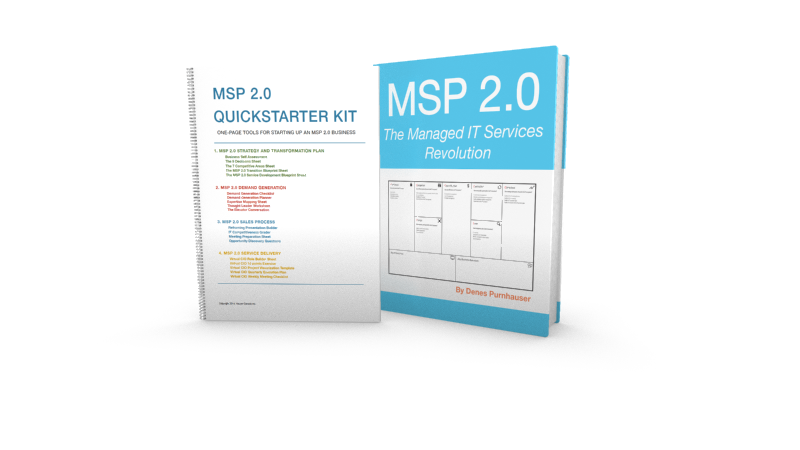
I have to admit we haven't done a lot of blogging lately and there hasn't been a lot of new content, sorry. We do have an excuse: we have completed a book about the MSP 2.0 business model.
We got your awesome feedback on our content- thanks - including the observations that our ideas were all in little pieces, lacking real connection. We needed a more comprehensive and linear format to digest this new concept, and thought that the best way to do so was to write a book. Have a look at what we have to offer in this format, and how you can become a contributing part of the story.
The concept of this book is first to analyse the current situation and then to create the practical but holistic approach to make MSP 2.0 a reality. We wanted to deliver a business-minded explanation about the industry we are in. We have an MSP (Hauser Canada) that we plan to make successful over the next 5-10 years. Everyone sees the problems and the turmoil in the industry, but not the complete solution. We didn’t want to talk tactics, or how to sell the cloud, how to price, or package better. We wanted to show a very viable strategy toward the next evolution of the MSP model and what is needed to move quickly on that path.
We observed that while there is proven prosperity in the MSP program, on the ‘break and fix’ model, but we didn’t have a complete business strategy. It has been a long process to change the model, and most IT managed services providers still have a majority of these contracts. Our goal is to clear the slate and see what’s next:
Introduction:
The MSP 2.0 business model is a great blend of the MSP fixed-fee model combined with the much broader scope of IT Consultancy. This book illustrates that new model such that you can see how an MSP can build a scalable business around it.
Chapter 1: Business Focus or Technology focus:
Many IT companies says they are "Business Focused" but what does that really mean? What are the prerequisites to be able to make that claim? What is behind the value proposition?
Chapter 2: Why the MSP 1.0 model is broken?
Unfortunately, the initial Value Proposition of the IT managed services providers is broken. Nobody really cares about the infrastructure any more. It is a commodity, like electricity, and thus the subject is not part of the C level conversation.
Chapter 3: Opportunity of the MSP 2.0 model
Meanwhile a substantial untapped potential is arising from the client side: the quest to be more competitive with the help of IT...to grow faster, service clients better, and communicate more efficiently. How do you address this huge opportunity?
Chapter 4: Why is it so difficult?
Do you remember how hard it was to switch from the ‘break and fix’ model to the MSP? There are two major obstacles along the way to implementing the MSP 2.0. This is going to be work too, but there are shortcuts.
Chapter 5: Requirements of the next generation program
If we want to tackle this in a systematic way, what do we need to address - the hurdles along the way we need to prepare for eliminate? What should be the scope for such a program, and what types of components should it have?
Chapter 6: The first Complete MSP 2.0 program
The complete program has many layers, like the framework, education, software, community, business building, and processes for each and every stakeholder. The client, who gets the value, the virtual CIO who delivers that value, and the leader of the MSP who is building the business.
Chapter 7: The Client Perspective
What does the client need to achieve competitive edge? Reduce the complexity of the IT, create transparency and a systematic approach to progress, ensure accountability, and effective collaboration.
Chapter 8: Virtual CIO Perspective
What the Virtual CIO needs to deliver is value in a scalable and efficient way: quick client discovery, implementation of core vCIO services and an IT management framework, effective management of IT Projects including collaboration with the clients.
Chapter 9: The Leader of the MSP perspective
What does the leader need to build a business? A Transition Blueprint Program, Self Assessment, Business Model Analysis, Creating the MSP 2.0 Value Proposition, Inbound Marketing Engine, Lead Generation engine, Predictable Sales, and Implementing the Virtual CIO services.
Chapter 10: The Roadmap for success
What is the typical roadmap for IT managed services providers of different maturities, size, and service offerings? What are the foundations and services needed to implement immediately and grow quickly?
STRUCTURE, MANAGE AND AUTOMATE YOUR ACCOUNT MANAGEMENT AND VCIO PROCESESS

